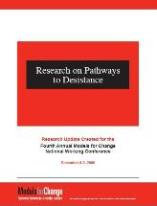
 Does the juvenile justice system really work?
Does the juvenile justice system really work?
Reading comments from readers on news stories about youth in trouble, you'd think the juvenile justice sysem was a system designed to mollycoddle dangerous kids, turning them into super-predators.
Nothing could be further from the truth.
Among other reasons, we know this because of "Pathways to Desistance," a research study led by Edward P. Mulvey, Director of the Law and Psychiatry Program at Western Psychiatric Institute and Clinic at the University of Pittsburgh School of Medicine. (Dr. Mulvey and Carol Schubert contributed a post to us on their findings in April 2010.)
The "Pathways to Desistance" research study is a unique study of what works in the juvenile justice system. This large, multi-site research project followed 1,354 serious juvenile offenders for seven years. An informative brief on the study findings was released in 2009 by the MacArthur Foundation; now, the Office of Juvenile Justice and Delinquency Prevention (OJJDP) has released another fact sheet, titled, "Highlights From Pathways to Desistance: A Longitudinal Study of Serious Adolescent Offenders."
Here's what the study found:
- Most youth quit or reduce their offending over time. Only 8.5 percent of the youth in the study persisted at high levels of offending. As Dr. Mulvey explains in the OJJDP fact sheet,
"Two factors that appear to distinguish high-end desisters from persisters are lower levels of substance use and greater stability in their daily routines, as measured by stability in living arrangements and work and school attendance."
- Providing services and sanctions based on individual need -- factors including substance abuse, mental health needs, family background -- could be more effective than providing them based on severity of the crime and prior convictions. Surprisingly, the researchers found that the youth who persisted in offending and those who reduced their offending behavior got about the same kind and intensity of services.
- In a related finding, the study found that incarceration did not reduce offending. In fact, for the subgroup of serious juvenile offenders who greatly reduced their offending after contact with the justice system -- who spent about 30 percent of the study followup period in institutional care -- incarceration actually increased their offending to a small, but statistically signifcant degree.
If locking them up didn't help, what did? Community-based services and probation supervision. As Dr. Mulvey writes,
"Youth who received community-based supervision and aftercare services were more likely to attend school, go to work, and avoid further offending during the 6 months after release, and longer supervision periods increased these benefits."
- For many of these youth -- those meeting their definition of "serious juvenile offenders" -- substance abuse treatment is key, as the MacArthur Foundation brief makes clear:
"Levels of substance use and associated problems are very high in these young offenders. More than one-third qualify for a diagnosis of substance use disorder in the year prior to the baseline interview, and over 80 percent report having used drugs or alcohol during the previous six months. Moreover, the level of substance use walks in lockstep with illegal activity over the follow-up period: more substance use, more criminal offending."
Treating youth for at least 90 days, with their family members involved, cut both their substance abuse and their offending, at least during the six months after treatment. (Tellingly, the sub-study this conclusion was based on, "Substance use treatment outcomes in a sample of male serious juvenile offenders," which appeared in 2009 in the Journal of Substance Abuse Treatment, found that only 25% of the serious juvenile offenders in its sample received treatment that included family members. The study authors speculated that this might be partly because these offenders were being treated in secure institutional environments, rather than the community.)
In an age when every state is trying to find money to fund juvenile justice services, policy makers should be turning to this research to help them guide funding to what works in juvenile justice.
The above story is reprinted with permission from Reclaiming Futures, a national initiative working to improve alcohol and drug treatment outcomes for youth in the juvenile justice system.
